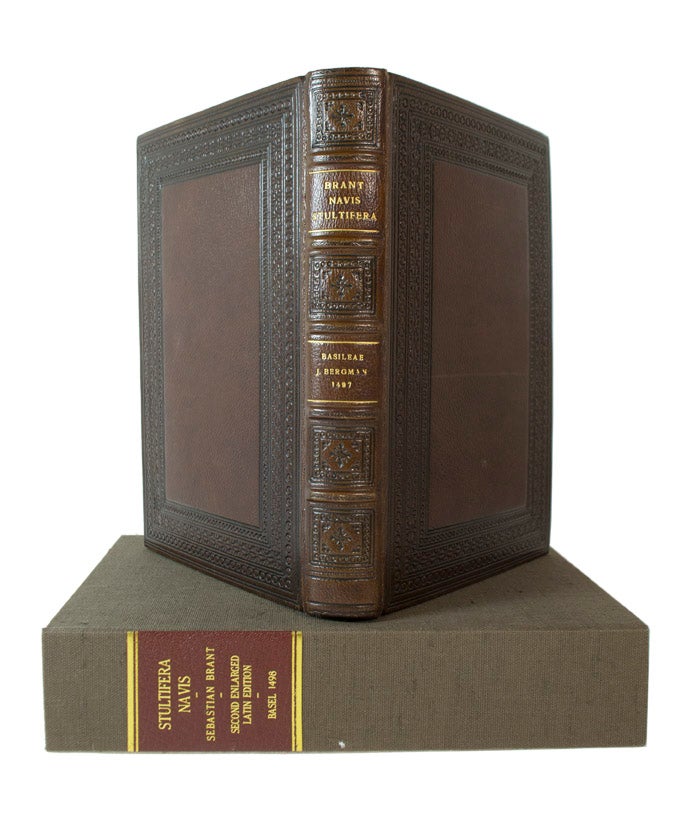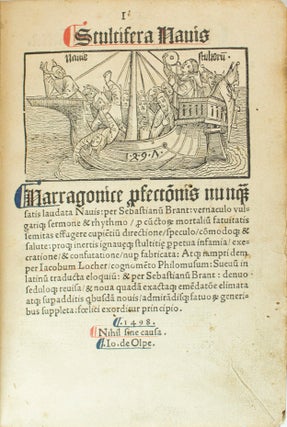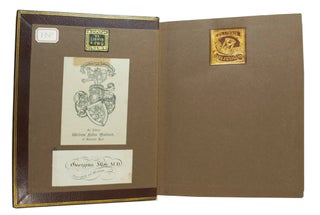“The Ship of Fools” Illustrated by Durer and Others
Stultifera navis.
Basel: Johann Bergmann de Olpe, 1498.
Translated into Latin by Jacobus Locher “Philomusus” in collaboration with Brant, and with additions by Thomas Beccadelli]. [Basel]: Johann Bergmann de Olpe, [1 March] 1498.
Second enlarged Latin edition (first published in German in 1494 by the same printer). Small quarto (8 1/2 x 6 1/4 inches; 216 x 159 mm.). 164 leaves (CXLIIII, [4], CXLV- CLIX, [1, blank]). Collation: a-s8 4 t-y4 (a1r title with woodcut, a1v Locher’s epigrams to the reader and letter to Brant, a3v verses by Brant and Locher to each other, to Bergmann, and on Narragonia, a7r Locher’s prologue, a8v Brant’s verse prologue and argument, b3r text, 1v additional material by Brant and Beccadelli, x4r epigrams by Beccadelli, x4v colophon and printer’s device, y1r register, y4 blank). Roman letter with gothic headings. Thirty lines plus headline with foliation. Three-line Lombard initials. With 117 woodcuts, including repeats and three full-page cuts, by Albrecht Dürer, the Master of Haintz Narr, the Master of the Gnad Her, and two other anonymous woodcut artists, woodcut printer’s device (Bergmann’s second device, with date 1497), decorative woodcut border to cuts on s2v and s4r and to printer’s device. Rubricated throughout, with paragraph marks in alternating red and blue and capital strokes and underlining in red.
Nineteenth-century brown morocco. Covers with wide decorative blind-tooled border, spine decoratively tooled in blind and ruled and lettered in gilt in compartments, wide turn-ins ruled in gilt, top edge gilt, fore-edge lettered in manuscript. A single contemporary flyleaf preserved at each end. A few small wormholes (worming slightly heavier at beginning and end), some very light browning. An exceptionally fresh and bright copy of this extremely rare and very early edition. Housed in a cloth clamshell case.
Only three copies of this edition have sold at auction in the last twenty-five years: the Morgan Library copy in 1981, waterstained and with title soiled and weakened by acid, a copy in 1988 lacking twelve leaves, and a final copy in 1998 in a modern binding and with all the leaves washed.
From the library of Helmut N. Friedlaender, with his booklabel on front pastedown. Armorial bookplate of William Fuller Maitland (1813-1876), bookplate of Georg Kloss (1787-1854), and leather booklabel of E.Ph. Goldschmidt (1887-1954) also on front pastedown. Leather booklabel of Carl J. Ulmann on front free endpaper, with his pencilled collation notes on front flyleaf (sale, Parke-Bernet, 15 April 1952, lot 60). Early bookseller’s description affixed to front flyleaf.
"‘The Ship of Fools’ is the most important of a long line of moralizing works in which the weaknesses and vices of mankind are satirized as follies. The tradition goes back to early medieval times both in England and on the Continent...In a ship laden with one hundred fools, steered by fools to the fools’ paradise of Narragonia, Brant satirizes all the weakness, follies and vices of his time. Composed in popular humorous verse and illustrated by a remarkable series of woodcuts...the book was an immediate success. Brant’s purpose was a moral one: he wanted to improve the life of his contemporaries and to help in the regeneration of the Holy Roman Empire and the Church...the book also contains the earliest literary reference to the discovery of America [on k4v]; the Columbus Letter had been published by the same printer the year previously. The influence of ‘The Ship of Fools’ was extensive and prolonged: thirty-six editions were published between 1494 and 1513...There were twelve translations in about forty different editions. Its most immediate imitators were Geiler von Kaisersberg, Thomas Murner, Hans Sachs and Johannes Fischart in Germany, where the ‘Narr’ as a type has lived until today. Erasmus’s Moriae Encomium was directly inspired by it. ‘The Ship of Fools’ was the first original work by a German which passed into world literature...[It] played an important part in European literature, and helped to blaze the trail that leads from medieval allegory to modern satire, drama and the novel of character” (Printing and the Mind of Man).
The Latin version of Das Narrenschiff was made under Brant’s close supervision by his favorite pupil Jacobus Locher (1471-1528). This edition contains additional poems by Brant and Thomas Beccadelli. The interpolated quire contains further additions by Beccadelli and is also found inserted as a supplement in some copies of Bergmann’s first enlarged Latin edition of 1 August 1497.
The majority of the fine woodcut illustrations are those commissioned for the editio princeps of 1494, many of which are now recognized as the work of Albrecht Dürer. F. Winkler, in Dürer und die Illustrationen zum Narrenschiff (Berlin, 1951), attributed as many as seventy-three to the young artist, who resided in Basel for a few months in 1494. To the original series are added about a dozen new cuts which Bergmann had already used in his second German edition of 1495, first Latin edition of 1 March 1497, and first enlarged Latin edition of 1 August 1497. The original Basel series of illustrations was as influential as Brant’s text, with all subsequent editions deriving from it.
Alden and Landis 498/5. BSB-Ink B-821. CIBN B-760. Goff B-1091. GW 5062. Hain *3751. Polain 4092. Proctor 7778. Schramm XXII, Tafel 147-177. Schreiber 3572. Printing and the Mind of Man 37 (citing the 1494 first edition).
HBS 66885.
$60,000.
Price: $60,000.00
Item #66885



